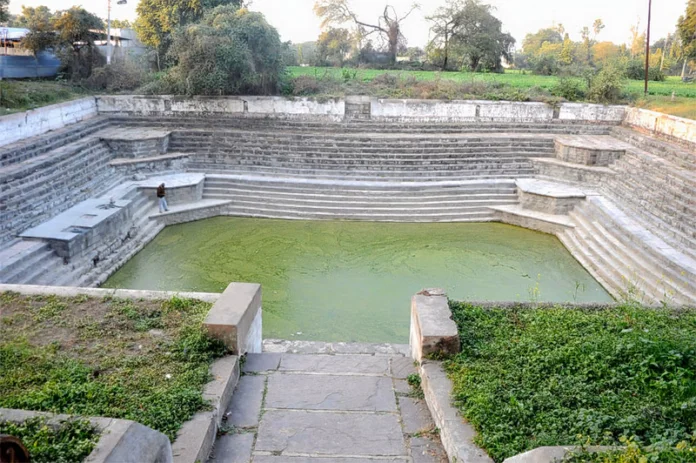
-Mitali Mishra
What is Gomti Kund?
Once, in the ashram of Maharishi Sandeepani, there was a beautiful pond known as Gumti Kund. Lord Shri Krishna himself established it. One day, Lord Shri Krishna observed that Maharishi Sandeepani went to perform various morning rituals, including bathing in the Gomti River using his yogic powers. Lord Shri Krishna felt distressed seeing his guru having to travel such a distance every day for bathing. He requested Maharishi Sandeepani to explain the reason for his distant bathing ritual. Maharishi Sandeepani explained that since his childhood, he had grown up near the banks of the Gomti River by the grace of his gurus. He received his desired abilities through their blessings and hence, it became his custom to bathe in the waters of Gomti Maya every morning.
Lord Shri Krishna offered to manifest the waters of Gomti Maya there itself through his grace and blessings, sparing Maharishi Sandeepani the need to travel. Initially sceptical, Maharishi Sandeepani agreed to Lord Shri Krishna’s proposal. After bathing in the Gomti River, Maharishi Sandeepani left his water pot and wooden sandals at the riverbank and returned to his ashram. Lord Shri Krishna, awaiting his return, greeted him with reverence and then invoked the presence of Gomti Maya’s waters. He shot an arrow so swiftly that it pierced through the Earth to the netherworld, creating a massive chasm resembling a cow’s mouth, from which a stream of water flowed. This stream gradually formed a large reservoir, later known as Gumti Kund.
Upon seeing the miraculous transformation, Maharishi Sandeepani realised the sanctity of Gomti Maya’s waters. Since then, he revered Lord Shri Krishna and Lord Shiva inwardly, acknowledging their blessings. The spot where Lord Shri Krishna used to wash his angavastram and where his footprints naturally appeared on a stone slab still exists in Gumti Kund. This legendary site is where Maharishi Sandeepani and Lord Shri Krishna used to meditate together.
Architectural Beauty
The architecture surrounding the Kund reflects the rich cultural heritage of Ujjain, with intricate carvings and sculptures adorning its periphery. Devotees often offer prayers and light lamps around its serene banks, creating an aura of spirituality and reverence. The structures surrounding the Kund often include pavilions, known as mandapas, where devotees can sit and meditate, seek blessings from priests, or participate in religious ceremonies. These mandapas are adorned with elaborate pillars, domes, and arches, showcasing the architectural prowess of ancient artisans.
The Serenity
It’s a serene spot where people gather to establish a connection with something greater than themselves; it’s not just any pond.
With the passage of time, Gumti Kund has stood vigilant over the city for ages. It is more than just a body of water; it is a haven of calm and understanding as well as a symbol of faith.
The ability of Gumti Kund to unite people is what makes it unique. When you visit Gumti Kund, you feel that you’re a part of something bigger, regardless of who you are or where you’re from. It serves as a reminder that everyone in this vast planet is connected. It seems as though time slows down at Gumti Kund. You can pause to reflect on life, ponder the secrets of the cosmos, and experience a greater sense of divine connection. But Gumti Kund is more than just a location—it’s a place brimming with legends and recollections. Every ripple in the water represents a person who has found serenity or a sense of community.
It serves as a reminder that there is always somewhere to turn for comfort and hope, regardless of the difficulties we encounter.
The Visit Guide
Located in Ujjain, Madhya Pradesh, it’s accessible by road, rail, or air. Indore Airport is the nearest, about 55 km away, with taxis and buses readily available. From Ujjain Railway Station, it’s a short drive. Numerous accommodations are available in Ujjain for a convenient stay. Timing and transport options ensure a hassle-free visit to the sacred Gomti Kund.
The best time to visit the Gumti Kund in Ujjain is during the Kumbh Mela, which occurs every 12 years, attracting millions of pilgrims. Other auspicious times include major Hindu festivals like Mahashivaratri and Navratri. Cooler months, from October to March, offer more comfortable weather for sightseeing. These times provide an opportunity to experience the spiritual ambiance and vibrant atmosphere surrounding the Kund. Ultimately, the choice depends on personal preferences, but attending during festivals or the Kumbh Mela ensures an unforgettable experience of devotion and cultural richness.

